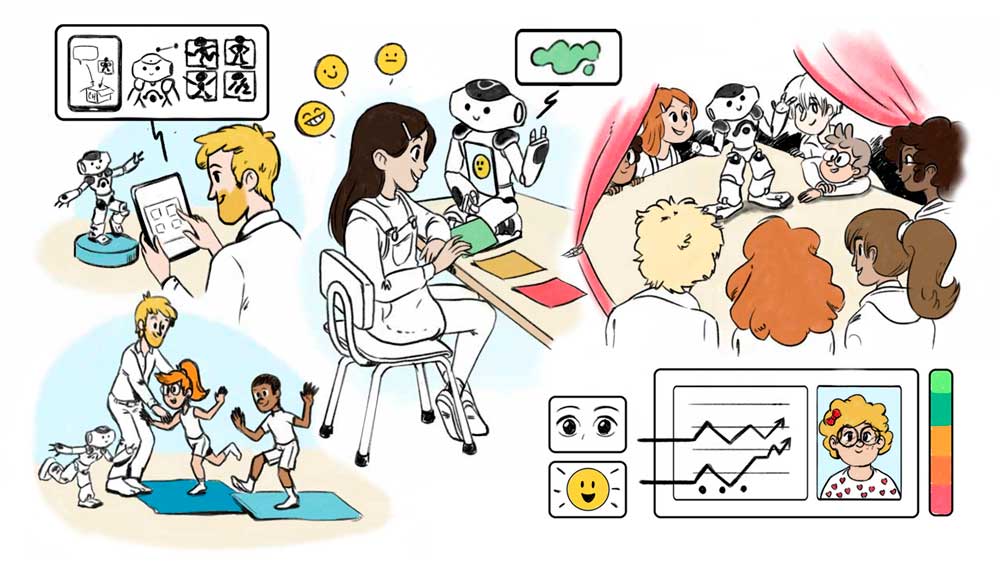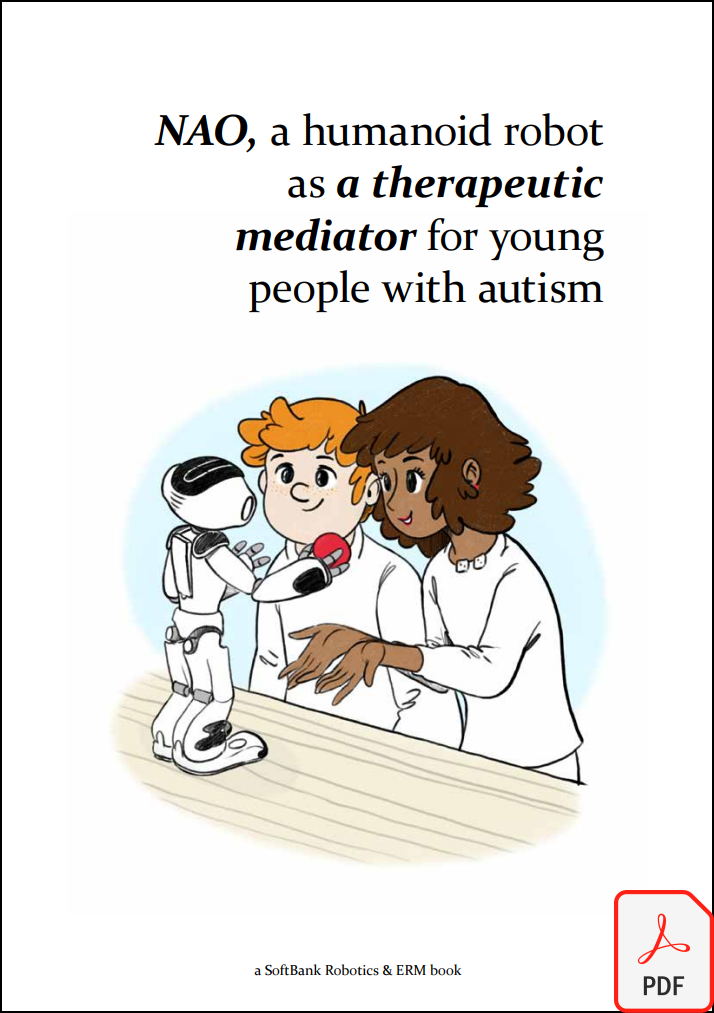In recent decades, robotics has established itself as a specific field of research within the world of healthcare and education. This is also the case with children with neurodevelopmental disorders. Driving the expansion of social robotics is the fact that it has the potential to surpass the limits of classic therapeutic activities, by overcoming their lack of intensity for example, and that it can be provided in a natural context despite its artificial nature, which could help with the generalisation of the progress made. Many studies have been taking place regarding robotics and neurodevelopmental disorders for almost a decade, creating an emerging area of study which shows no sign of slowing down.
Currently, there are a number of robots on the market that promise to help children with autism spectrum disorder and other neurodevelopmental disorders to develop their social skills and learning and to support them in their education; a prospect that could fundamentally change treatment. As a professor at Sorbonne University, Head of the Child and Adolescent Psychiatry Department at the Pitié-Salpêtrière Hospital within the AP-HP (Greater Paris University Hospitals), and a member of the Social Robotics, Interactions and Perception (PIRoS) team at the Institute of Intelligent Systems and Robotics (ISIR) of the CNRS (French National Centre for Scientific Research), I have myself contributed to this emerging field alongside the pioneers of the field with my engineer colleagues Mohamed Chetouani (1), Sofiane Boucenna (2) and Salvatore Anzalone (3). Technological progress has enabled innovation in a multitude of treatments for children with autism spectrum disorder and other neurodevelopmental disorders. One specific area is social robotics, which centres around evaluating relationships between humans and robots.
In the field of neurodevelopmental disorders, robots have been used both in clinical and educational environments. Educational robotics refers to robots specifically designed to interact with children during their educational activities. In the field of education, children with neurodevelopmental disorders are considered as children with special educational needs. Traditionally, approaches within educational robotics have been divided into learning about robots on the one hand and learning with robots on the other. In other words, robotics education versus robotics for education. The first approach relates to technical teaching focused on robotics while the second involves teaching different subjects (technical and other) using robotics. The use of educational robotics can be part of the school curriculum or an extracurricular activity (4).
Despite the many studies carried out, there is no clear evidence in the literature that robots can be used effectively to treat children with autism spectrum disorder and to support their learning process as children with special educational needs (5). With that in mind, it is fundamentally important to make the distinction between robots used for children with special educational needs and robots used by students with special educational needs. For example, by robots used for children with special educational needs, we mean robots used to improve the level of attention of children with neurodevelopmental disorders during diagnosis and/or treatment. In this case, the robots are just auxiliary tools to be used during this clinical time in the same way as any other technological device. In the case of robots used by children with special educational needs, however, the robots are considered as tools used to teach subjects on the school curriculum through activities focused on computational thinking to promote active learning.
When Alexandre Mazel from Softbank Robotics asked me to write the preface for the white paper on NAO and autism spectrum disorder, I hesitated at first. For one thing, Softbank Robotics is a business I do not have any particular links with. For another, the white paper on the use of NAO with autistic children is not strictly speaking a review article or even an exhaustive overview of the topic. It is more of a collection of feedback from users who have used NAO with patients with autism spectrum disorder. The users are teachers, psychologists and special educators (including healthcare professionals) or engineers and researchers in computational science. Some use NAO practically as it is delivered by Softbank Robotics, while others add new features.
At the same time, I have to recognise that NAO remains one of the most widely-used robotic platforms. In a recent study of the scientific literature conducted by one of my colleagues, Charline Grossard, we collated almost 14 scientific studies using NAO for therapeutic purposes and 4 using Kaspar, while all of the other robotic platforms covered (Charlie, THEO4, QT robot, Ribit, Caro, etc.) had only occasionally been used in studies (5). As it happens, I have used NAO myself in several projects, including very recently in work on handwriting correction (6) (a video is available at the following link: https://youtu.be/0iLScP0Pjz). In addition, as a child and adolescent psychiatrist, I was interested in the idea of giving a platform for feedback from real-life users, some of whom lay outside the mould of scientific research teams. So, dear reader, what will you find in this white paper? I would like to do something different and introduce the paper from the perspective of the different ways NAO has been used.
I’ll start first of all with how it is used by specialist teachers. The first account is from Thierry Le Buhé, a specialist teacher working in a day clinic, who gives us an ethnographic description of the children’s engagement with NAO, who are receiving treatment. The teacher controlled NAO himself and offered four types of activities; dictation, reading, imitation and risk-taking in terms of balance. On the whole, he observed good engagement from the children, often seeing better levels of attention, and found that NAO was a good supplement to existing teaching tools. The second experiment is more valuable in some ways since it was carried out at the scale of a whole school district, namely the Dijon school district. It targeted children at nursery school, with the teachers having been trained in the use of NAO with a view to using it for group activities, like saying hello, or singing nursery rhymes, but also individual activities – recognising words and yoga-type motor skills activities. Something extremely interesting is that the team had incorporated some information on the education of children with neurodevelopmental disorders for the teachers, which meant they were able to ask NAO questions and receive answers. Two researchers from INSHEA (higher national institute of training and research for the education of disabled young people and adapted teaching) have observed the different trials in the classes and are yet to do a qualitative and quantitative analysis of all these experiments. Nonetheless, the quantity of activities offered and the scale of this trial already show how easy NAO is to use and how well children engage with it.
The last educational robotics project was a collaboration between a team of support engineers (Movia) and West Hartford Public Schools. In this project, the Wizard of Oz technique was used, meaning that NAO was controlled by an operator. A dozen children were involved in the experiment for six to eight weeks with two sessions per week, the robot being controlled by an engineer and the specialist teacher being present at the session. The programme of activities was tailored according to the children’s specific abilities, but we do not have detail on the activities carried out, or even the scores used. Regardless, the authors do describe four individuals who demonstrated quantifiable improvements, but in the qualitative description they also indicated that one pupil disengaged from the robot.
The second type of use described in this white paper is use in a clinical environment. We essentially have two of these, the first being the use of NAO by clinical psychologist Olivier Duris, working in a day clinic. He put together two groups of six children, who attended 50 group storytelling sessions at the day clinic, with or without NAO. On a qualitative level, it shows that NAO’s presence improved the children’s understanding and participation in the storytelling groups NAO was involved in. The quantitative aspects are not really described but have been measured and will probably be the subject of future publications. The second clinical use described in the white paper was a collaboration between the university hospital in Nantes and an engineering support team led by Sophie Sakka. This time, use of NAO was offered as a group activity where one or more robots were programmed in preparation for a drama activity involving a robot. Here again, the team describe the qualitative progress of individual children but also the group dynamic when children with neurodevelopmental disorders were put into groups with one or more robots. The last three contributions to the white paper are all from engineering teams, with or without clinicians, offering a number of adaptable solutions enabling different activities. The HERO team, which I was delighted to find includes Giuseppe Palestra, a former member of ISIR, offers 18 different exercises thanks to the development of an interface enabling different activities to be run with NAO. Dr Fady Al Najjar’s team offer dialogues, motor skills activities and role play games thanks to a solution combining NAO and a mobile phone with pictograms showing emotions. And finally the DREAM project team offers imitation, joint attention and turn-taking activities. In most cases, these teams are also working on producing metrics from sensors, recording audio and also video which gives them quantitative variables concerning eye contract, joint attention, facial expression, taking turns to speak, etc. All these solutions must be clinically validated, however, to show the accuracy of the metrics and also their relevance, which is not necessarily available as things are. However, the DREAM project has announced a large randomised controlled trial including 69 children over eight sessions, the results of which could be an important step.
All in all, I believe that this white paper will give readers a good demonstration of the vitality of the social robotics field in relation to autism spectrum disorder and how NAO has played a part in this vitality for many years now, through its ease of use by clinicians or teachers who are not necessarily specialists in robotics, but also through the simplicity of integrating new algorithms and solutions created by engineers wishing to increase the interactive capabilities of the NAO robotic platform. It is probably this design and ease of use that are behind the success reported in these many accounts from real-life users.
David Cohen MD, PhD
Professor, Sorbonne University, Head of the Child and Adolescent Psychiatry Department, Institute of Intelligent Systems and Robotics (CNRS research group UMR 7222), Pitié-Salpêtrière Hospital, AP-HP (Greater Paris University Hospitals), Paris, France
1. Boucenna S, Cohen D, Meltzoff A, Gaussier P, Chetouani M. Cognitive developmental robotics: How robots learn to recognize individuals from imitating children with autism and other agents. Scientific Report 2016; 6: e19908; doi:10.1038/srep19908
2. Boucenna S, Anzalone S, Tilmont E, Cohen D, Chetouani M and the Michelangelo Study Group. Extraction of social signatures through imitation learning between a robot and a human partner. IEEE Transactions on Autonomous Mental Development 2014; 99: DOI: 10.1109/TAMD.2014.2319861
3. Anzalone SM, Tilmont E, Boucenna S, Xavier J, Maharatna K, Chetouani M, Cohen D, and the Michelangelo Study Group. How children with autism spectrum disorder explore the 4-dimension (spatial 3D+time) environment during a joint attention induction task. Research in Autism Spectrum Disorders 2014; 8: 814–826.
4. Pivetti M, Di Battista S, Agatolio F, et al. Educational robotics for children with neurodevelopmental disorders: a systematic review. Heliyon 6 2020; 10: e05160.
5. Grossard C, Palestra G, Xavier J, Chetouani M, Grynszpan O, Cohen D. ICT and autism care: state of the art. Curr Opin Psychiatry. 2018; 31: 474-483.
6. Gargot T, Asselborn T, Zammouri I, Brunelle J, Johal W, Dillenbourg P, Archambault D, Chetouani M, Cohen D, Anzalone SM. «It is not the robot who learns, it is me» Treating severe dysgraphia using Child-Robot Interaction. Frontiers in Psychiatry 2021; 12: e5. doi: 10.3389/fpsyt.2021.596055

